Analysis of Incorporating a Phase Change Material in a Roof for the Thermal Management of School Buildings in Hot-Humid Climates
Abstract
1. Introduction
2. Materials and Methods
2.1. Building Prototype and Simulations Procedure
2.2. Selection of Performance Indicators
2.3. Usage Efficiency of PCM
2.4. Evaluation of Thermal Comfort and Energy-Saving Potential
3. Results and Discussion
3.1. Cooling Load and Thermal Environment with No PCM Roof
3.2. Influence of PCM on The Energy Consumption of the Air-Conditioning Season
3.3. Influence of PCM on Thermal Comfort in the Ventilation Season
3.4. Efficiency of PCM
3.5. Selection of PCM
4. Conclusions
Author Contributions
Funding
Institutional Review Board Statement
Informed Consent Statement
Data Availability Statement
Conflicts of Interest
References
- Wang, X.; Sun, X.; Yu, C.W.F. Building envelope with variable thermal performance: Opportunities and challenges. Indoor Built Environ. 2018, 27, 729–733. [Google Scholar] [CrossRef]
- Zhou, Y.; Yu, C.W. The year-round thermal performance of a new ventilated Trombe wall integrated with phase change materials in the hot summer and cold winter region of China. Indoor Built Environ. 2019, 28, 195–216. [Google Scholar] [CrossRef]
- Madad, A.; Mouhib, T.; Mouhsen, A. Phase Change Materials for Building Applications: A Thorough Review and New Perspectives. Buildings 2018, 8, 63. [Google Scholar] [CrossRef]
- Al-Yasiri, Q.; Szabó, M. Incorporation of phase change materials into building envelope for thermal comfort and energy saving: A comprehensive analysis. J. Build. Eng. 2021, 36, 102122. [Google Scholar] [CrossRef]
- Stamatiadou, M.E.; Katsourinis, D.I.; Founti, M.A. Computational assessment of a full-scale Mediterranean building incorporating wallboards with phase change materials. Indoor Built Environ. 2016, 26, 1429–1443. [Google Scholar] [CrossRef]
- Ramakrishnan, S.; Sanjayan, J.; Wang, X. Experimental Research on Using Form-stable PCM-Integrated Cementitious Composite for Reducing Overheating in Buildings. Buildings 2019, 9, 57. [Google Scholar] [CrossRef]
- Bravo, J.P.; Venegas, T.; Correa, E.; Álamos, A.; Sepúlveda, F.; Vasco, D.A.; Barreneche, C. Experimental and Computational Study of the Implementation of mPCM-Modified Gypsum Boards in a Test Enclosure. Buildings 2020, 10, 15. [Google Scholar] [CrossRef]
- Kim, T.; Ahn, S.; Leigh, S.-B. Energy consumption analysis of a residential building with phase change materials under various cooling and heating conditions. Indoor Built Environ. 2014, 23, 730–741. [Google Scholar] [CrossRef]
- Tokuç, A.; Yesügey, S.C.; Başaran, T. An evaluation methodology proposal for building envelopes containing phase change materials: The case of a flat roof in Turkey’s climate zones. Arch. Sci. Rev. 2017, 60, 408–423. [Google Scholar] [CrossRef]
- Alqallaf, H.J.; Alawadhi, E.M. Concrete roof with cylindrical holes containing PCM to reduce the heat gain. Energy Build. 2013, 61, 73–80. [Google Scholar] [CrossRef]
- Mushtaq, T.H.; Ahmed, Q.M.; Hasanain, M.H. Experimental and Numerical Study of Thermal Performance of a Building Roof Including Phase Change Material (PCM) for Thermal Management. 2013. Available online: http://ijersonline.org/HTML_Papers/Research Journal of Engineering and Technology__PID__2013-4-3-7.html (accessed on 31 October 2013).
- Zwanzig, S.D.; Lian, Y.; Brehob, E.G. Numerical simulation of phase change material composite wallboard in a multi-layered building envelope. Energy Convers. Manag. 2013, 69, 27–40. [Google Scholar] [CrossRef]
- Xamán, J.; Rodriguez-Ake, A.; Zavala-Guillén, I.; Hernández-Pérez, I.; Arce, J.; Sauceda, D. Thermal performance analysis of a roof with a PCM-layer under Mexican weather conditions. Renew. Energy 2020, 149, 773–785. [Google Scholar] [CrossRef]
- Mourid, A.; El Alami, M. Thermal Behavior of a Building Provided With Phase-Change Materials on the Roof and Exposed to Solar Radiation. Sol. Energy Eng. 2017, 139, 061012. Available online: https://asmedigitalcollection.asme.org/solarenergyengineering/article-abstract/139/6/061012/379777 (accessed on 24 December 2019). [CrossRef]
- Piselli, C.; Castaldo, V.L.; Pisello, A.L. How to enhance thermal energy storage effect of PCM in roofs with varying solar reflectance: Experimental and numerical assessment of a new roof system for passive cooling in different climate conditions. Sol. Energy 2019, 192, 106–119. [Google Scholar] [CrossRef]
- Beltrán, R.D.; Martínez-Gómez, J. Analysis of phase change materials (PCM) for building wallboards based on the effect of environment. J. Build. Eng. 2019, 24, 100726. [Google Scholar] [CrossRef]
- Reddy, K.S.; Mudgal, V.; Mallick, T.K. Thermal Performance Analysis of Multi-Phase Change Material Layer-Integrated Building Roofs for Energy Efficiency in Built-Environment. Energies 2017, 10, 1367. [Google Scholar] [CrossRef]
- Li, D.; Zheng, Y.; Liu, C.; Wu, G. Numerical analysis on thermal performance of roof contained PCM of a single residential building. Energy Convers. Manag. 2015, 100, 147–156. [Google Scholar] [CrossRef]
- Roman, K.K.; O’Brien, T.; Alvey, J.; Woo, O. Simulating the effects of cool roof and PCM (phase change materials) based roof to mitigate UHI (urban heat island) in prominent US cities. Energy 2016, 96, 103–117. [Google Scholar] [CrossRef]
- Yu, J.; Yang, Q.; Ye, H.; Luo, Y.; Huang, J.; Xu, X.; Gang, W.; Wang, J. Thermal performance evaluation and optimal design of building roof with outer-layer shape-stabilized PCM. Renew. Energy 2020, 145, 2538–2549. [Google Scholar] [CrossRef]
- Li, D.; Wu, Y.; Zhang, G.; Arıcı, M.; Liu, C.; Wang, F. Influence of glazed roof containing phase change material on indoor thermal environment and energy consumption. Appl. Energy 2018, 222, 343–350. [Google Scholar] [CrossRef]
- Jin, X.; Medina, M.A.; Zhang, X. Numerical analysis for the optimal location of a thin PCM layer in frame walls. Appl. Therm. Eng. 2016, 103, 1057–1063. [Google Scholar] [CrossRef]
- Heim, D.; Wieprzkowicz, A. Positioning of an isothermal heat storage layer in a building wall exposed to the external environment. J. Build. Perform. Simul. 2015, 9, 542–554. [Google Scholar] [CrossRef]
- Murathan, E.K.; Manioğlu, G. Evaluation of phase change materials used in building components for conservation of energy in buildings in hot dry climatic regions. Renew. Energy 2020, 162, 1919–1930. [Google Scholar] [CrossRef]
- Yang, L.; Qiao, Y.; Liu, Y.; Zhang, X.; Zhang, C.; Liu, J. A kind of PCMs-based lightweight wallboards: Artificial controlled condition experiments and thermal design method investigation. Build. Environ. 2018, 144, 194–207. [Google Scholar] [CrossRef]
- Cascone, Y.; Capozzoli, A.; Perino, M. Optimisation analysis of PCM-enhanced opaque building envelope components for the energy retrofitting of office buildings in Mediterranean climates. Appl. Energy 2018, 211, 929–953. [Google Scholar] [CrossRef]
- Muruganantham, K. Application of Phase Change Material in Buildings: Field Data vs. EnergyPlus Simulation. Arizona State University, December 2010; p. 84. Available online: http://repository.asu.edu/attachments/56138/content/Muruganantham_asu_0010N_10151.pdf (accessed on 1 December 2010).
- Jamil, H.; Alam, M.; Sanjayan, J.; Wilson, J.L. Investigation of PCM as retrofitting option to enhance occupant thermal comfort in a modern residential building. Energy Build. 2016, 133, 217–229. [Google Scholar] [CrossRef]
- Liu, J.; Liu, Y.; Yang, L.; Liu, T.; Zhang, C.; Dong, H. Climatic and seasonal suitability of phase change materials coupled with night ventilation for office buildings in Western China. Renew. Energy 2020, 147, 356–373. [Google Scholar] [CrossRef]
- Berardi, U.; Soudian, S. Benefits of latent thermal energy storage in the retrofit of Canadian high-rise residential buildings. Build. Simul. 2018, 11, 709–723. [Google Scholar] [CrossRef]
- Sage-Lauck, J.; Sailor, D. Evaluation of phase change materials for improving thermal comfort in a super-insulated residential building. Energy Build. 2014, 79, 32–40. [Google Scholar] [CrossRef]
- Ramakrishnan, S.; Wang, X.; Alam, M.; Sanjayan, J.; Wilson, J.L. Parametric analysis for performance enhancement of phase change materials in naturally ventilated buildings. Energy Build. 2016, 124, 35–45. [Google Scholar] [CrossRef]
- Biopcm Webpage.Pdf. Available online: https://phasechange.com/biopcm/ (accessed on 12 May 2021).
- What is BioPCM®? Available online: https://phasechange.com/biopcm/ (accessed on 12 May 2021).
- Lomas, K.J.; Porritt, S.M. Overheating in buildings: Lessons from research. Build. Res. Inf. 2016, 45, 1–18. [Google Scholar] [CrossRef]
- Teli, D.; Bourikas, L.; James, P.; Bahaj, A.S. Thermal Performance Evaluation of School Buildings using a Children-based Adaptive Comfort Model. Procedia Environ. Sci. 2017, 38, 844–851. [Google Scholar] [CrossRef]
- Liang, H.-H.; Lin, T.-P.; Hwang, R.-L. Linking occupants’ thermal perception and building thermal performance in naturally ventilated school buildings. Appl. Energy 2012, 94, 355–363. [Google Scholar] [CrossRef]
- ISO. ISO 7730:2005 Ergonomics of the Thermal Environment—Analytical Determination and Interpretation of Thermal Comfort Using Calculation of the PMV and PPD Indices and Local Thermal Comfort Criteria. Available online: https://www.iso.org/standard/39155.html (accessed on 1 November 2005).
- Pomianowski, M.; Heiselberg, P.; Zhang, Y. Review of thermal energy storage technologies based on PCM application in buildings. Energy Build. 2013, 67, 56–69. [Google Scholar] [CrossRef]
- Waqas, A.; Din, Z.U. Phase change material (PCM) storage for free cooling of buildings—A review. Renew. Sustain. Energy Rev. 2013, 18, 607–625. [Google Scholar] [CrossRef]
- Zhou, D.; Zhao, C.; Tian, Y. Review on thermal energy storage with phase change materials (PCMs) in building applications. Appl. Energy 2012, 92, 593–605. [Google Scholar] [CrossRef]
- Zhu, N.; Liu, P.; Liu, F.; Hu, P.; Wu, M. Energy performance of double shape-stabilized phase change materials wallboards in office building. Appl. Therm. Eng. 2016, 105, 180–188. [Google Scholar] [CrossRef]
- Zhu, N.; Hu, N.; Hu, P.; Lei, F.; Li, S. Experiment study on thermal performance of building integrated with double layers shape-stabilized phase change material wallboard. Energy 2019, 167, 1164–1180. [Google Scholar] [CrossRef]
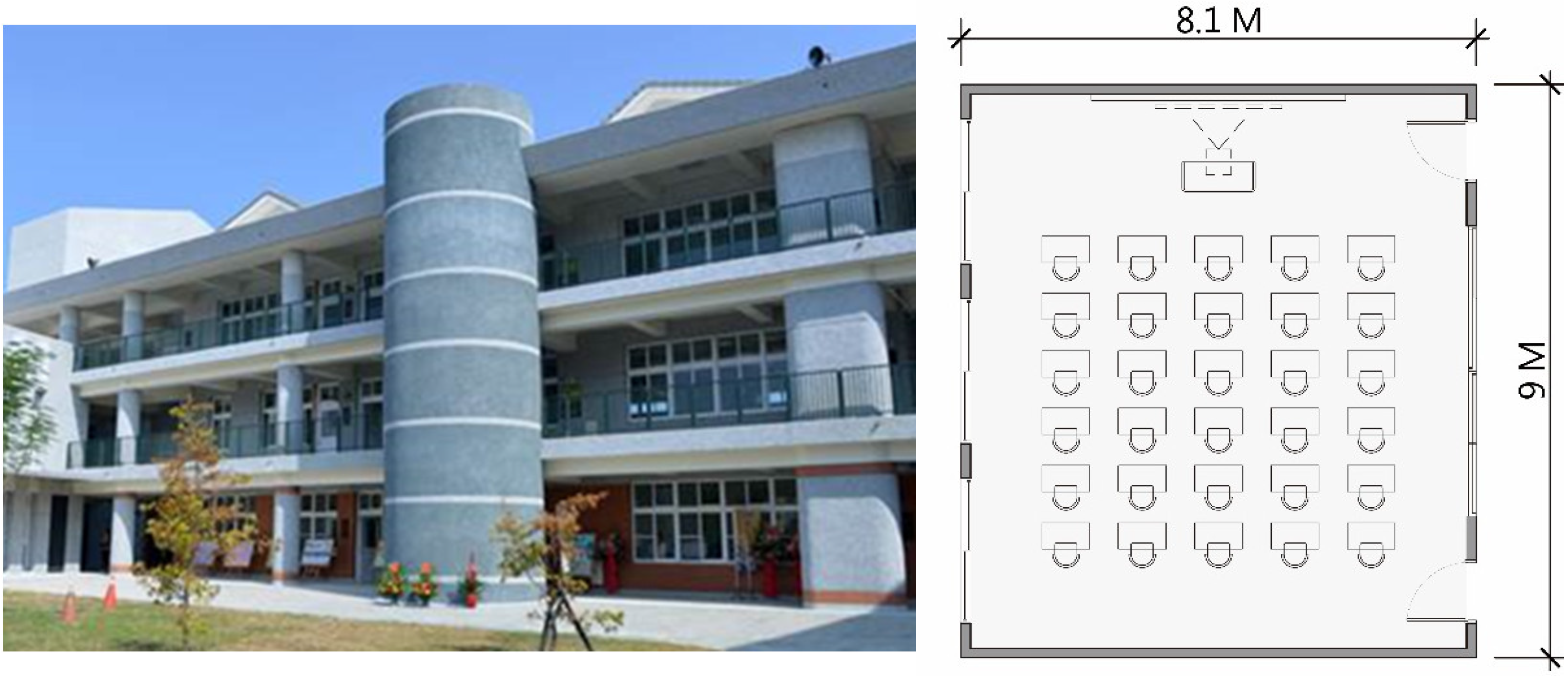
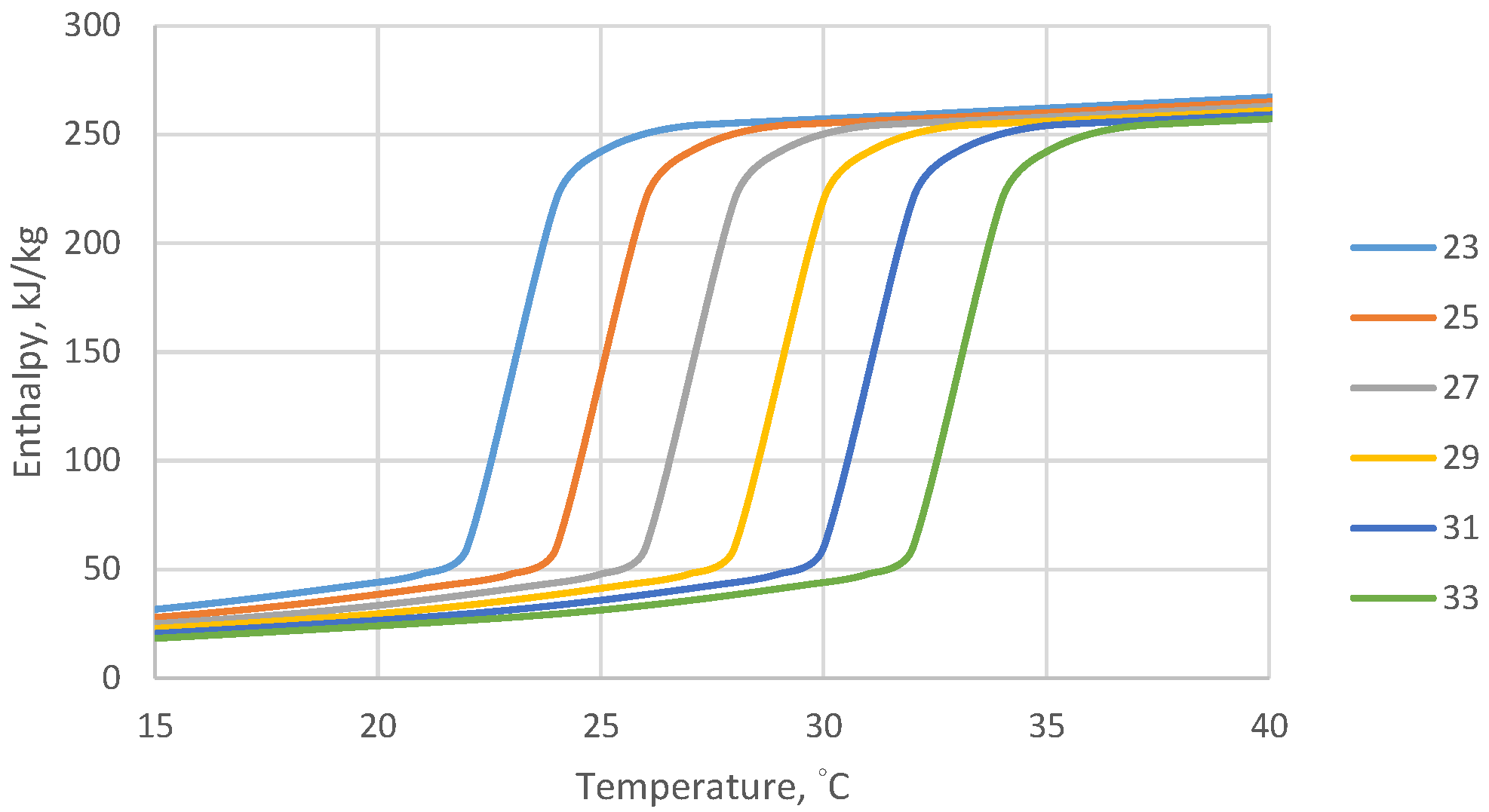



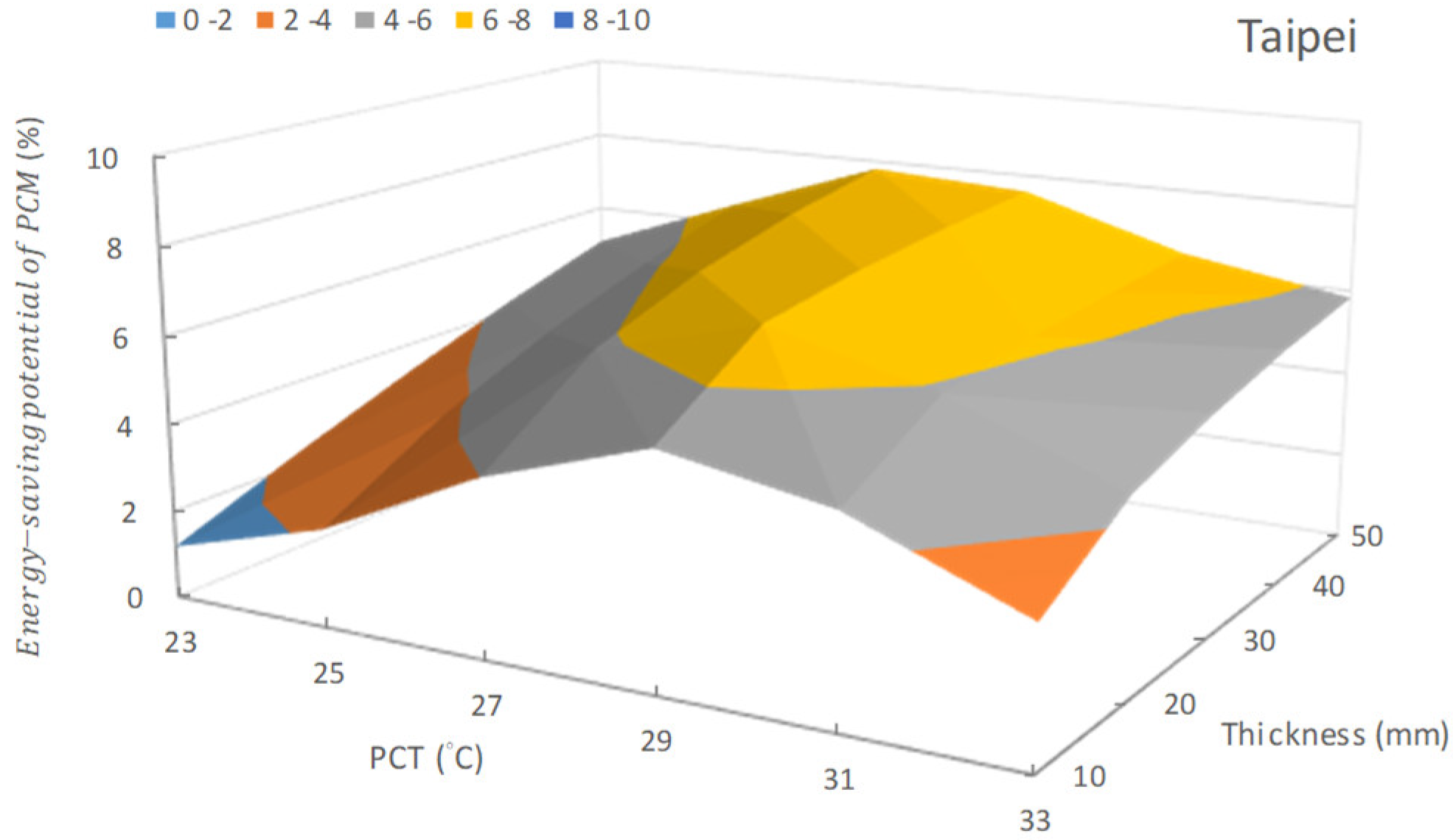
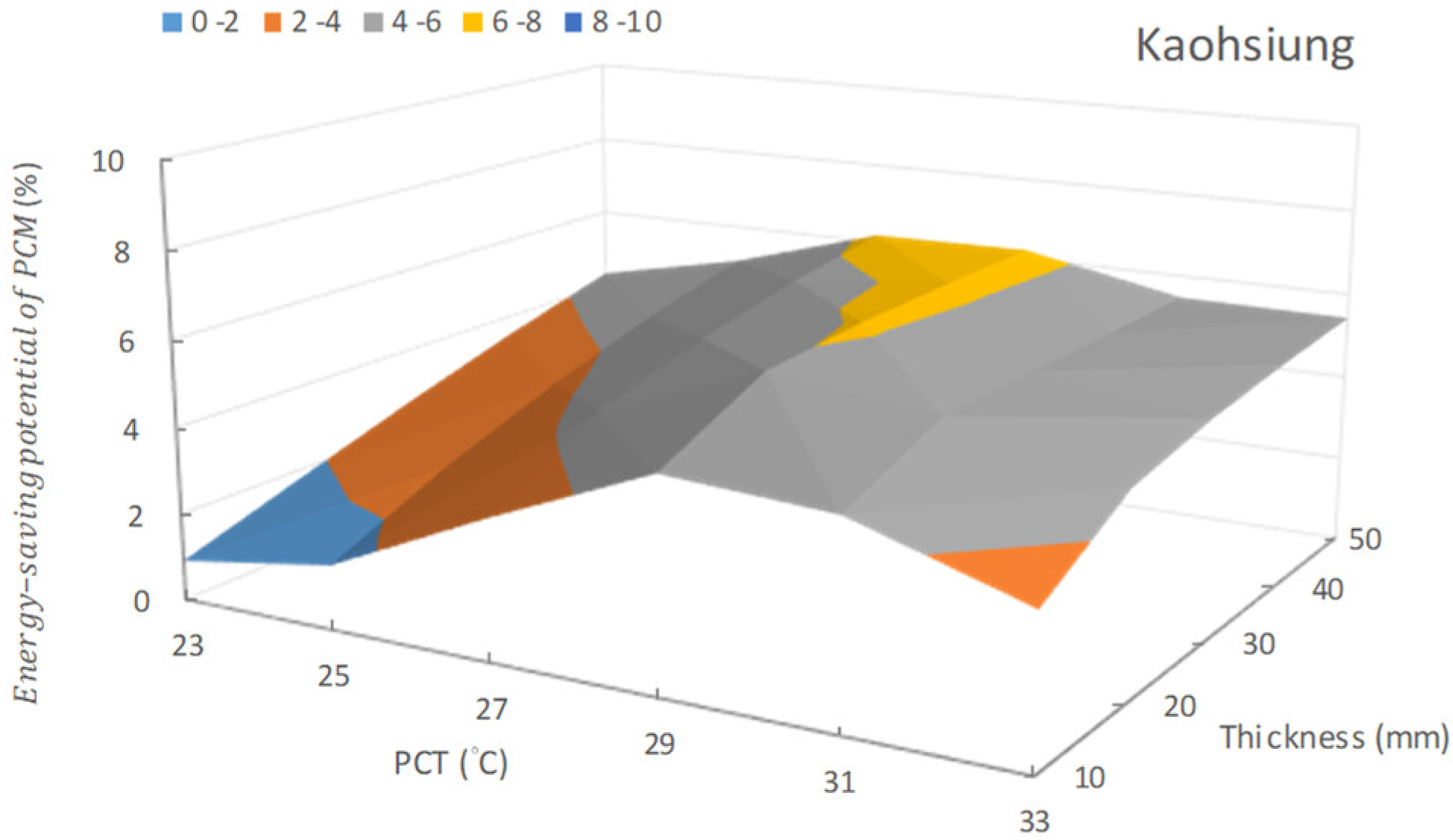
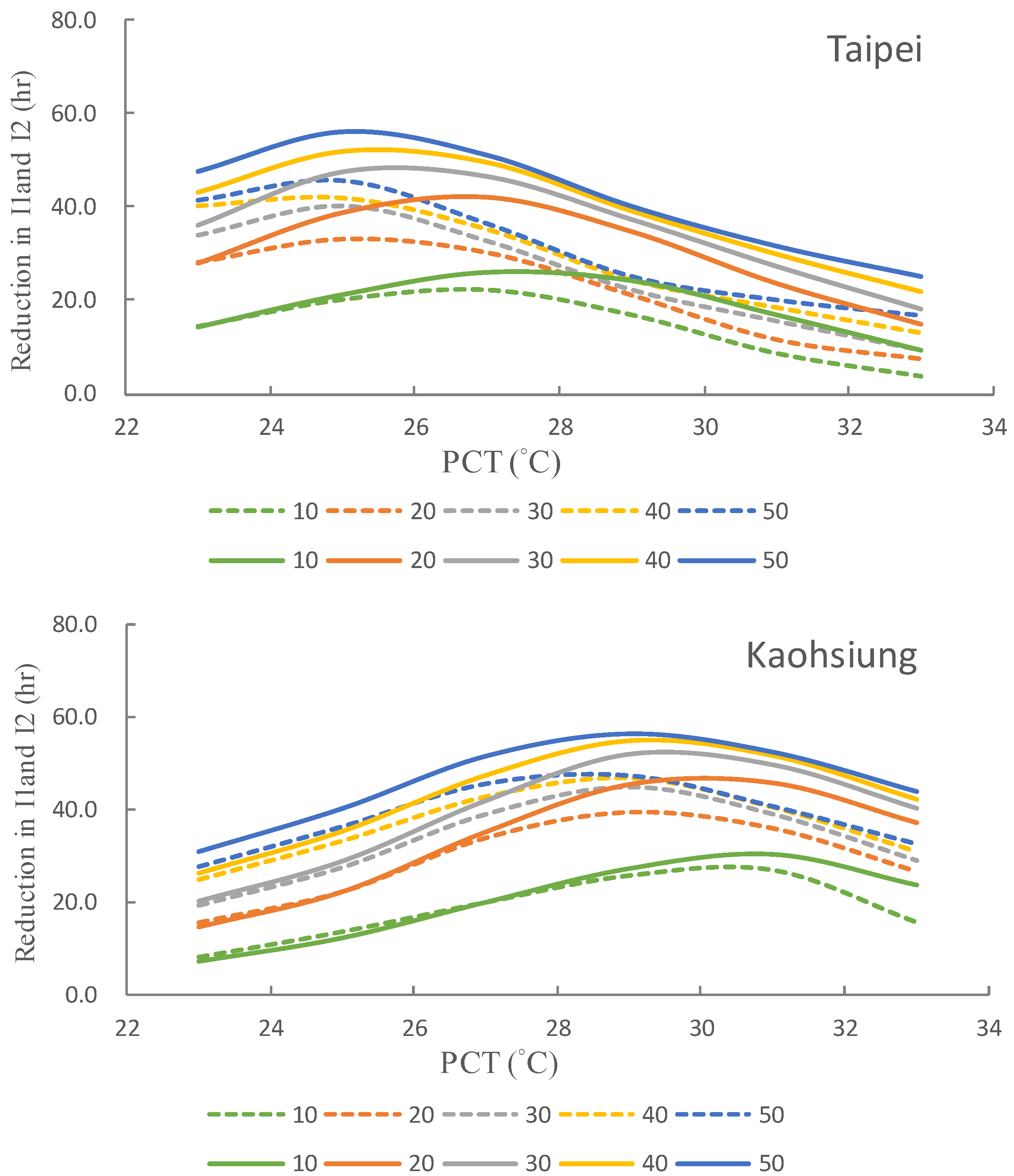
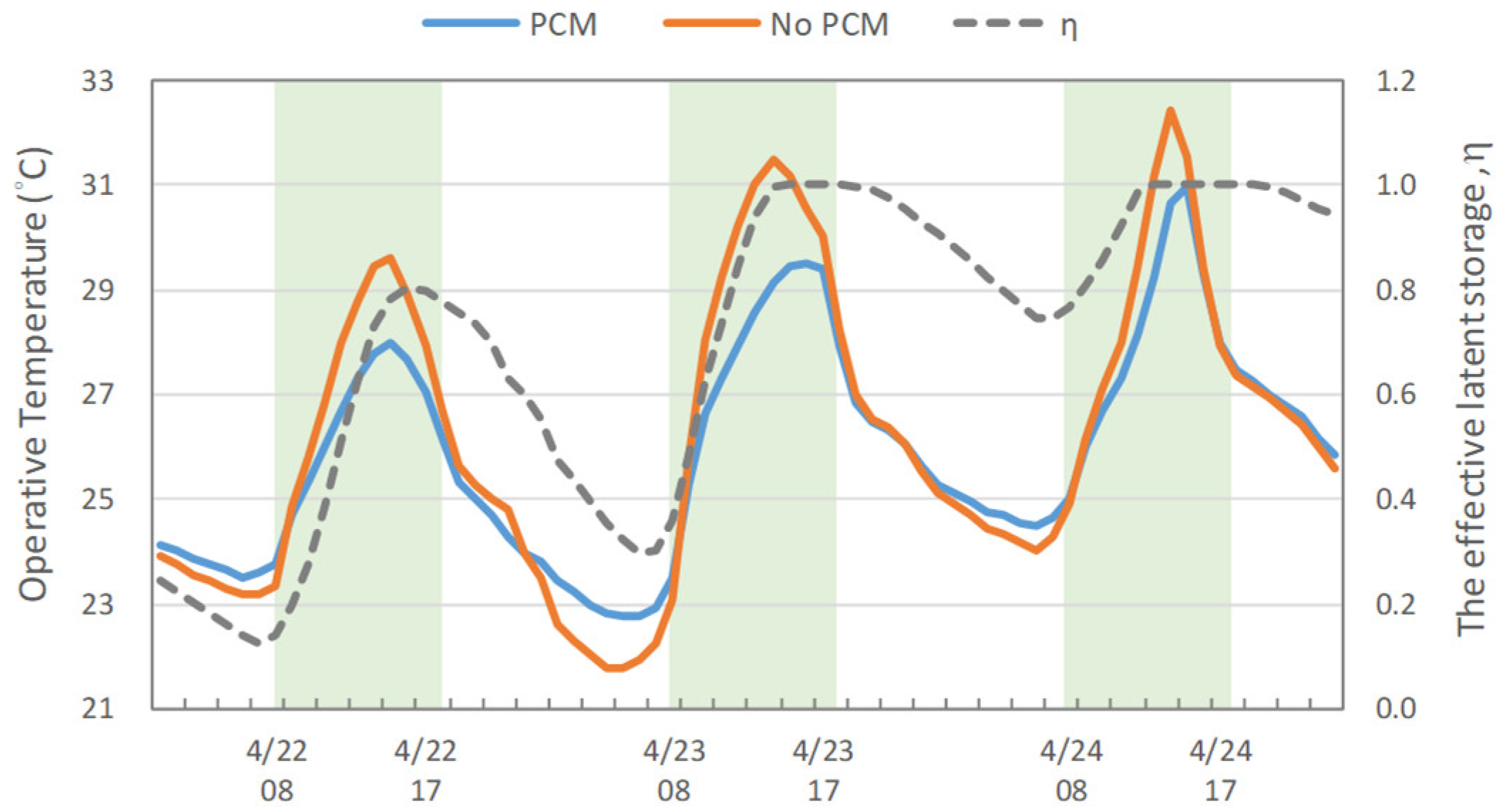
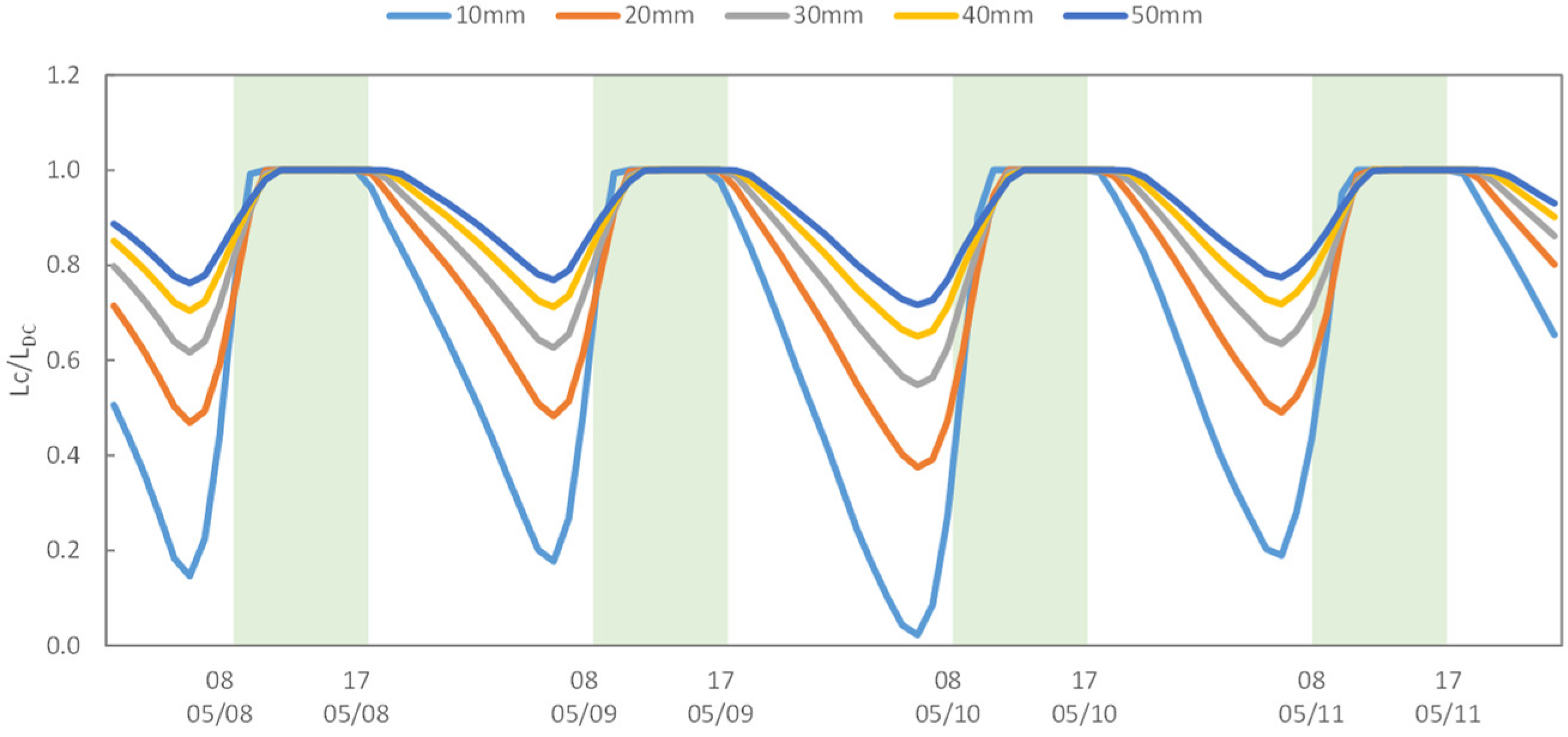
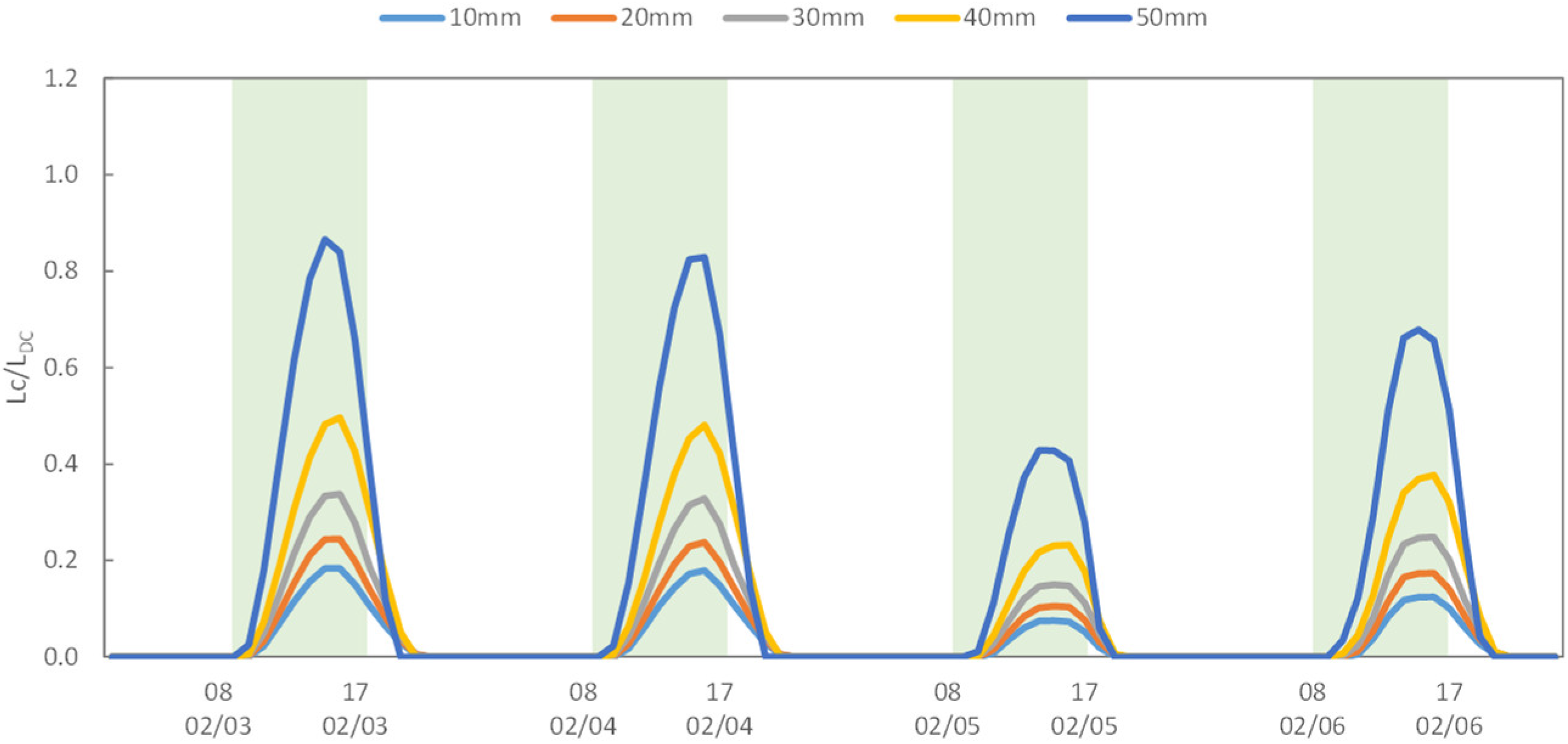

| Building | Orientation | Face Toward the South |
|---|---|---|
| Story | 3 Stories | |
| Classroom | Length × width × height | 9.0 m × 8.1 m × 3.6 m |
| Lighting density | 12 W/m2 | |
| Room capacity | 30 people (including teachers and students) | |
| Occupancy period | 8:00–17:00 (weekdays) | |
| Window-wall ratio | North: 29%; South: 37% | |
| Material of facade and roof structure | Window glass | 6 mm thick clear glass |
| Exterior wall | Reinforced concrete (RC) U value: 2.3 W/m2K | |
| Roof | RC roof with 25 mm polystyrene (PS) insulation board (U value: 1.0 W/m2K) |
| May to October (Air-Conditioning Season) | November to April (Ventilation Season) | |||||
|---|---|---|---|---|---|---|
| Cooling load (GJ) | Ratio (%) | I1 (hours) | Ratio (%) | I2 (hours) | Ratio (%) | |
| Taipei | 13.2 | 20.4% | 104.0 | 44.4% | 274.1 | 52.8% |
| Kaohsiung | 15.7 | 19.7% | 221.0 | 64.2% | 445.9 | 68.5% |
| May to October (Air-Conditioning Season) | November to April (Ventilation Season) | |||||||||
|---|---|---|---|---|---|---|---|---|---|---|
| Thicknesses of PCM (mm) | 10 | 20 | 30 | 40 | 50 | 10 | 20 | 30 | 40 | 50 |
| PCT (°C, Taipei) | 29 | 29 | 29 | 29 | 27 | 27 | 25 | 25 | 25 | 25 |
| PCT (°C, Kaohsiung) | 29 | 29 | 29 | 29 | 29 | 31 | 29 | 29 | 29 | 29 |
| Thickness (mm) | May to October (Air-Conditioning Season) | November to April (Ventilation Season) | ||||||||||||
|---|---|---|---|---|---|---|---|---|---|---|---|---|---|---|
| PCT (°C) | Storing | Releasing | PCT (°C) | Storing | Releasing | |||||||||
| TC | LC | CE | TDC | LDC | HE | TC | LC | CE | TDC | LDC | HE | |||
| Taipei | ||||||||||||||
| 10 | 29 | 0.62 | 0.57 | 0.58 | 0.44 | 0.62 | 0.50 | 25 | 0.30 | 0.38 | 0.33 | 0.33 | 0.43 | 0.35 |
| 20 | 29 | 0.71 | 0.42 | 0.53 | 0.57 | 0.45 | 0.49 | 25 | 0.37 | 0.29 | 0.32 | 0.40 | 0.32 | 0.34 |
| 30 | 29 | 0.73 | 0.31 | 0.47 | 0.61 | 0.34 | 0.44 | 25 | 0.39 | 0.21 | 0.29 | 0.44 | 0.25 | 0.32 |
| 40 | 29 | 0.74 | 0.25 | 0.42 | 0.65 | 0.27 | 0.41 | 25 | 0.41 | 0.17 | 0.26 | 0.46 | 0.20 | 0.29 |
| 50 | 29 | 0.74 | 0.21 | 0.39 | 0.67 | 0.23 | 0.38 | 25 | 0.42 | 0.14 | 0.24 | 0.47 | 0.17 | 0.27 |
| Kaohsiung | ||||||||||||||
| 10 | 29 | 0.79 | 0.69 | 0.73 | 0.46 | 0.72 | 0.55 | 29 | 0.37 | 0.62 | 0.47 | 0.45 | 0.68 | 0.53 |
| 20 | 29 | 0.85 | 0.49 | 0.64 | 0.60 | 0.51 | 0.54 | 29 | 0.48 | 0.49 | 0.48 | 0.56 | 0.51 | 0.52 |
| 30 | 29 | 0.86 | 0.37 | 0.56 | 0.67 | 0.39 | 0.49 | 29 | 0.51 | 0.36 | 0.43 | 0.60 | 0.38 | 0.46 |
| 40 | 29 | 0.86 | 0.30 | 0.50 | 0.71 | 0.31 | 0.45 | 29 | 0.53 | 0.28 | 0.38 | 0.62 | 0.30 | 0.42 |
| 50 | 29 | 0.86 | 0.25 | 0.45 | 0.75 | 0.26 | 0.43 | 29 | 0.54 | 0.23 | 0.35 | 0.63 | 0.24 | 0.38 |
| PCT (°C) | Overheating Hours, I1 (hr) | Weighted Overheating Hours, I2 (hr) | Energy-Saving Potential (GJ) |
|---|---|---|---|
| 25 | 80 | 206 | 2.5 (3.7%) |
| 29 | 51 | 184 | 4.7 (6.9%) |
| Difference | 29 | 22 | −2.2 (−3.2%) |
Publisher’s Note: MDPI stays neutral with regard to jurisdictional claims in published maps and institutional affiliations. |
© 2021 by the authors. Licensee MDPI, Basel, Switzerland. This article is an open access article distributed under the terms and conditions of the Creative Commons Attribution (CC BY) license (https://creativecommons.org/licenses/by/4.0/).
Share and Cite
Hwang, R.-L.; Chen, B.-L.; Chen, W.-A. Analysis of Incorporating a Phase Change Material in a Roof for the Thermal Management of School Buildings in Hot-Humid Climates. Buildings 2021, 11, 248. https://doi.org/10.3390/buildings11060248
Hwang R-L, Chen B-L, Chen W-A. Analysis of Incorporating a Phase Change Material in a Roof for the Thermal Management of School Buildings in Hot-Humid Climates. Buildings. 2021; 11(6):248. https://doi.org/10.3390/buildings11060248
Chicago/Turabian StyleHwang, Ruey-Lung, Bi-Lian Chen, and Wei-An Chen. 2021. "Analysis of Incorporating a Phase Change Material in a Roof for the Thermal Management of School Buildings in Hot-Humid Climates" Buildings 11, no. 6: 248. https://doi.org/10.3390/buildings11060248
APA StyleHwang, R.-L., Chen, B.-L., & Chen, W.-A. (2021). Analysis of Incorporating a Phase Change Material in a Roof for the Thermal Management of School Buildings in Hot-Humid Climates. Buildings, 11(6), 248. https://doi.org/10.3390/buildings11060248








